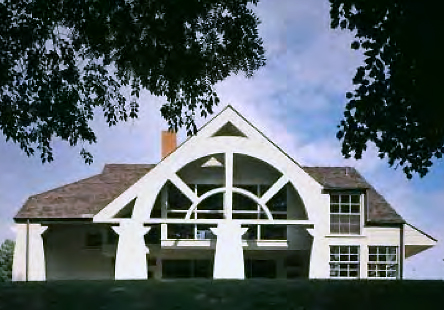Unit 4: Later Europe and Americas, 1750–1980 CE
Key Movements of Later Europe and Americas Art
The Enlightenment (1715 – 1789)
- During the Enlightenment, intellectuals and other thinkers began to see ancient concepts from a fresh viewpoint and advocated skepticism, the study of science, and reasoning over superstition.
- A greater emphasis was placed on individualism and religion (separate from religion). When painters were no longer limited to religious forms, the subject matter of artwork began to change.
- This age witnessed a growing appreciation for the natural world.
- This paved the way for the creation of numerous new artistic trends and genres.
French Revolution (1789-1799)
- People revolted at the unequal treatment of the Third Estate (commoners) by the government, persistent food shortages, and financial distress after fighting in the American Revolution.
- Symbolism in a number of paintings expressed political opinions and conveyed political messages about the current events.
- Romanticism, which concentrated on emotion and expressed the sublime, was one of the aesthetic trends that followed the French Revolution.
Publishing of the Communist Manifesto (1848)
- The Communist Manifesto was written by Karl Marx and Friedrich Engels in 1848.
- It was first published in German in London.
- This was commissioned by the Communist League, a political organization that sought to unite various socialist groups.
- The text outlines the principles of communism and critiques capitalism.
- The Manifesto argues that the history of society is a history of class struggle, and that the proletariat (working class) will eventually overthrow the bourgeoisie (capitalist class).
- The Manifesto had a significant impact on political and social movements around the world, and is considered one of the most influential political texts in history.
Revolutions of 1848
- The Revolutions of 1848 were a series of political uprisings across Europe.
- They were sparked by economic hardship, political repression, and demands for greater democracy and national unity.
- The revolutions began in France in February 1848 and quickly spread to other countries including Germany, Italy, and Austria-Hungary.
- Many of the revolutions were ultimately unsuccessful, with conservative forces reasserting control in most countries by the end of the year.
- The revolutions did lead to some important reforms, such as the abolition of serfdom in Austria-Hungary and the establishment of a constitutional monarchy in France.
Perry Expedition and the Forced Opening of Japan (1853-1868)
- Perry Expedition occurred between 1853-1854
- Led by Commodore Matthew Perry of the United States Navy
- Goal was to establish diplomatic relations with Japan and open trade
- Japan had been isolated from the rest of the world for over 200 years
- Negotiations were difficult due to language and cultural barriers
- Treaty of Kanagawa was signed in 1854, allowing American ships to refuel and resupply in two Japanese ports
- This forced Japan to open up to the world and establish trade relations with other countries
World Wars I and II (1914-1945)
- Both World Wars I and II had a profound impact on global economy, populations, and the environment.
- Like to earlier wars in history, art from World War I and World War II contains messages about the political and social climate.
- In particular, World War I gave rise to artistic styles such as Surrealism (abstract form intended to perplex the observer) and Expressionism (work that conveyed the creators' inner sentiments).
The Harlem Renaissance (1920s-1930s)
- The Harlem Renaissance was a cultural movement that took place in the 1920s and 1930s in Harlem, New York City.
- It was also known as the "New Negro Movement" and was characterized by a celebration of African American culture, art, music, and literature.
- The movement was fueled by the Great Migration, which brought thousands of African Americans from the South to the North in search of better opportunities.
- Prominent figures of the Harlem Renaissance include Langston Hughes, Zora Neale Hurston, Duke Ellington, and Louis Armstrong.
- The movement had a significant impact on American culture and helped to break down racial barriers and stereotypes.
Interactions Within and Across Cultures in Later European and American Art
- Influences of Non-Western Cultures
- Non-Western cultures, such as African, Asian, and Native American, influenced later European and American art.
- Artists were fascinated by the exoticism and spirituality of these cultures.
- They incorporated non-Western motifs, patterns, and techniques into their works.
- Influences of Eastern Cultures
- Eastern cultures, such as Japanese and Chinese, also influenced later European and American art.
- Artists were attracted to the simplicity, elegance, and harmony of these cultures.
- They adopted Eastern techniques, such as woodblock printing and calligraphy, and incorporated them into their works.
- Influences of Other Western Cultures
- Western cultures also influenced later European and American art.
- Artists were inspired by the art of their contemporaries and predecessors from other Western countries.
- They borrowed styles, techniques, and themes from these artists.
Artistic Movements of Later Europe and Americas Art
- Rococo (1700-1750 CE)
- Rococo art, which emerged in Europe between 1700 and 1750 CE, was characterized by its ornate and decorative style.
- Techniques and processes used in Rococo art included delicate brushwork, pastel colors, and asymmetrical compositions.
- Audience was primarily the aristocracy and wealthy bourgeoisie, who commissioned works for their homes and palaces.
- Interpretations vary, but it is often seen as a reflection of the hedonistic and pleasure-seeking culture of the time.
- Purpose was to create a sense of luxury and opulence, and to showcase the wealth and status of the patrons who commissioned the works.
- Neoclassicism (1750-1830)
- A revival of classical art and architecture, characterized by a focus on simplicity, order, and rationality.
- Techniques included drawing, painting, and sculpture.
- The audience was mainly the aristocracy and the bourgeoisie.
- The purpose was to promote the values of reason, order, and patriotism.
- Romanticism (1780-1850)
- An artistic and literary movement that emphasized emotion, imagination, and individualism.
- Techniques included painting, literature, and music.
- The audience was mainly the middle class.
- The purpose was to express personal feelings and emotions, and to critique society.
- Realism (1848-1900)
- An artistic movement that aimed to represent reality as it is, without idealization or exaggeration.
- Techniques included painting, sculpture, and photography.
- The audience was mainly the working class.
- The purpose was to expose social and political issues, and to promote social change.
- Impressionism (1860-1890)
- An artistic movement that aimed to capture the fleeting effects of light and color.
- Techniques included painting and drawing.
- The audience was mainly the middle class.
- The purpose was to capture the beauty of everyday life, and to challenge traditional art forms.
- Post-Impressionism (1880s-1890s)
- Emphasized the use of color and form to express emotions and ideas.
- Artists used techniques such as pointillism and bold brushstrokes to create a sense of movement and energy in their works.
- The purpose of Post-Impressionism was to move beyond the limitations of Impressionism and create a more personal and expressive form of art.
- Symbolism (1890s)
- Focused on the use of symbols and metaphors to convey deeper meanings and emotions.
- Artists used techniques such as exaggeration and distortion to create a dreamlike or mystical atmosphere in their works.
- The purpose of Symbolism was to explore the inner world of the human psyche and express the mysteries of the universe.
- Art Nouveau (1890s-1914)
- Emphasized the use of organic forms and decorative motifs inspired by nature.
- Artists used techniques such as curvilinear lines and asymmetrical shapes to create a sense of fluidity and movement in their works.
- The purpose of Art Nouveau was to create a new style that was both beautiful and functional, and to break away from the rigid forms of traditional art.
- The Prairie Style (1900-1930s)
- Emphasized the use of simple, geometric forms and natural materials such as wood and stone.
- Architects used techniques such as horizontal lines and open floor plans to create a sense of harmony and integration with the surrounding landscape.
- The purpose of the Prairie Style was to create a new form of architecture that was both functional and aesthetically pleasing, and to reflect the values of the American Midwest.
- Fauvism (1905-1908)
- Emphasized the use of bold, bright colors and simplified forms to create a sense of energy and emotion in their works.
- Artists used techniques such as thick brushstrokes and simplified shapes to create a sense of spontaneity and immediacy in their works.
- The purpose of Fauvism was to break away from the traditional forms of art and create a new form of expression that was both vibrant and emotional.
- Expressionism (1905-1925)
- An artistic movement that aimed to express subjective emotions and experiences. Techniques included painting, literature, and theater.
- The audience was mainly intellectuals and artists.
- The purpose was to challenge traditional art forms, and to express the anxieties and fears of modern life.
- Cubism (1907-1930s)
- Emphasized geometric shapes and multiple perspectives.
- Its purpose was to break away from traditional art and create a new visual language.
- The audience was primarily other artists and intellectuals.
- Constructivism (1914-1920s)
- Focused on the use of industrial materials and emphasized the importance of function over form.
- Its purpose was to create art that served a social purpose and could be used in everyday life.
- The audience was the working class and the goal was to inspire social change.
- Dada (1915-1922)
- Rejected traditional art and embraced absurdity and nonsense.
- Its purpose was to challenge societal norms and values.
- The audience was primarily other artists and intellectuals.
- DeStijl (1917-1930s)
- Emphasized simplicity and abstraction, using only primary colors and straight lines.
- Its purpose was to create a universal language of art that could be understood by all.
- The audience was artists and designers.
- The International Style (1920s-1930s)
- An architectural movement that emphasized functionality and minimalism.
- Its purpose was to create buildings that were efficient and could be mass-produced.
- The audience was architects and designers.
- The Harlem Renaissance (1920s-1930s)
- A cultural movement that celebrated African American art, literature, and music.
- Its purpose was to challenge racial stereotypes and promote African American culture.
- The audience was primarily African Americans.
- Mexican Muralists (1920s-1930s)
- Used large-scale murals to promote social and political messages.
- Its purpose was to educate the public and inspire social change.
- The audience was the general public.
- Surrealism (1920-1960)
- An artistic movement that aimed to explore the subconscious mind and the irrational.
- Techniques included painting, sculpture, and literature.
- The audience was mainly intellectuals and artists.
- The purpose was to challenge rationality and conventional morality, and to explore the mysteries of the human psyche.
- Abstract Expressionism/The New York School (1940s-1950s)
- Used large canvases, gestural brushstrokes, and unconventional tools. The process of creating the artwork was as important as the final product.
- Audience was primarily other artists, critics, and collectors. Interpretations varied, with some seeing it as a reaction against formalism and others as a reflection of post-World War II anxiety.
- Purpose was to create a new form of art free from traditional constraints and express innermost emotions and ideas.
- Pop Art (1950-1980)
- An artistic movement that celebrated popular culture and consumerism.
- Techniques included painting, sculpture, and graphic design.
- The audience was mainly the middle class.
- The purpose was to critique mass media and consumer culture, and to blur the boundaries between high and low art.
- Color Field Painting (1960s)
- Abstract painting style using large areas of flat color to create depth. Paint applied in multiple layers.
- Primarily for art collectors and museums.
- Reaction against gestural brushwork of Abstract Expressionism.
- Goal was to create an immersive experience for the viewer.
- Happenings (1960s)
- Performance art that was spontaneous and unscripted. Included music, dance, and multimedia elements.
- Aimed at young, countercultural crowds.
- Meant to break down boundaries between art and life.
- Goal was to create a sense of community and shared experience.
- Site Art (1970s-1990s)
- Art movement that created site-specific works.
- Techniques included sculpture, installation, and environmental art.
- Audience was often the general public in public spaces.
- Goal was to engage with the environment and challenge traditional notions of art.
- Aimed to create a sense of place and dialogue between art and the natural world.
Later Europe and Americas Artworks
➼ Portrait of Sor Juana Inés de la Cruz
Details
- By Miguel Cabrera
- 1750
- Made oil on canvas
- Found in Museo Nacional de Historia, Castillo de Chapultepec, Mexico
Function
- Many portraits survive, but all images derive from a now-lost self-portrait.
- Painting was done for her admirers 55 years after Sor Juana Inés’s death.
Content
- Portrayed seated in her library surrounded by symbols of her faith and her learning.
- She wears the habit of the religious order of the Hermits of Saint Jerome nuns of Mexico City; the habit includes the escudo—a framed vellum painting.
- Painting may have been inspired by the image of Saint Jerome seated at a desk.
- Escudo: a framed painting worn below the neck in a colonial Spanish painting
Context
- Sor Juana Inés (Sister Juana Agnes), a child prodigy (1651–1695).
- She was a criollo woman who became a nun in 1669.
- A feminist culture survived in Mexican convents, where privileged nuns could live in comfort with servants and households.
- Sor Juana was a literary figure who wrote books that were widely read; she also wrote poetry and theatrical pieces, and maintained a great library.
- Sor Juana was instrumental in giving girls an education in a male-dominated world.
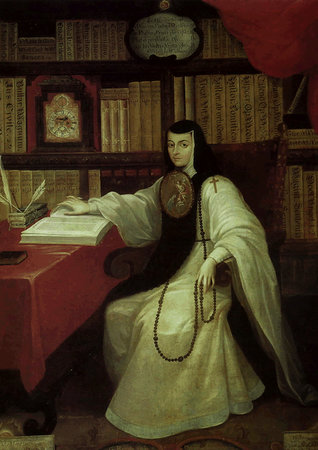
➼ The Swing
Details
- By Jean-Honoré Fragonard
- 1767
- Made of oil on canva
- Found in Wallace Collection, London
Form
- Pastel palette; light brushwork.
- Figures are small in a dominant garden-like setting.
- Use of atmospheric perspective.
- Puffy clouds; rich vegetation; abundant flowers; sinuous curves.
- Symbolically a dreamlike setting.
Patronage and Content
- Commissioned by an unnamed “gentleman of the Court:” a painting of his young mistress on a swing; in an early version, a bishop is pushing the swing with the gentleman admiring his mistress’s legs from below.
- In the finished painting, the older man is no longer a priest, a barking dog has been added, and Falconet’s sculpture of Menacing Love comments on the story.
- The patron in the lower left looks up the skirt of a young lady who swings flirtatiously, boldly kicking off her shoe at a sculpture.
- The dog in the lower right corner, generally seen as a symbol of fidelity, barks in disapproval at the scene before him.
Context
- Fragonard answers the libertine intentions of his patron by painting in the Rococo style.
- Fragonard often used different styles at the same time, and he seems to have seen the Rococo as particularly appropriate for an erotic scene.
- An intrigue painting; the patron hides in a bower; the garden sculpture of Menacing Love asks the lady to be discreet and may be a symbol for the secret hiding of the patron.
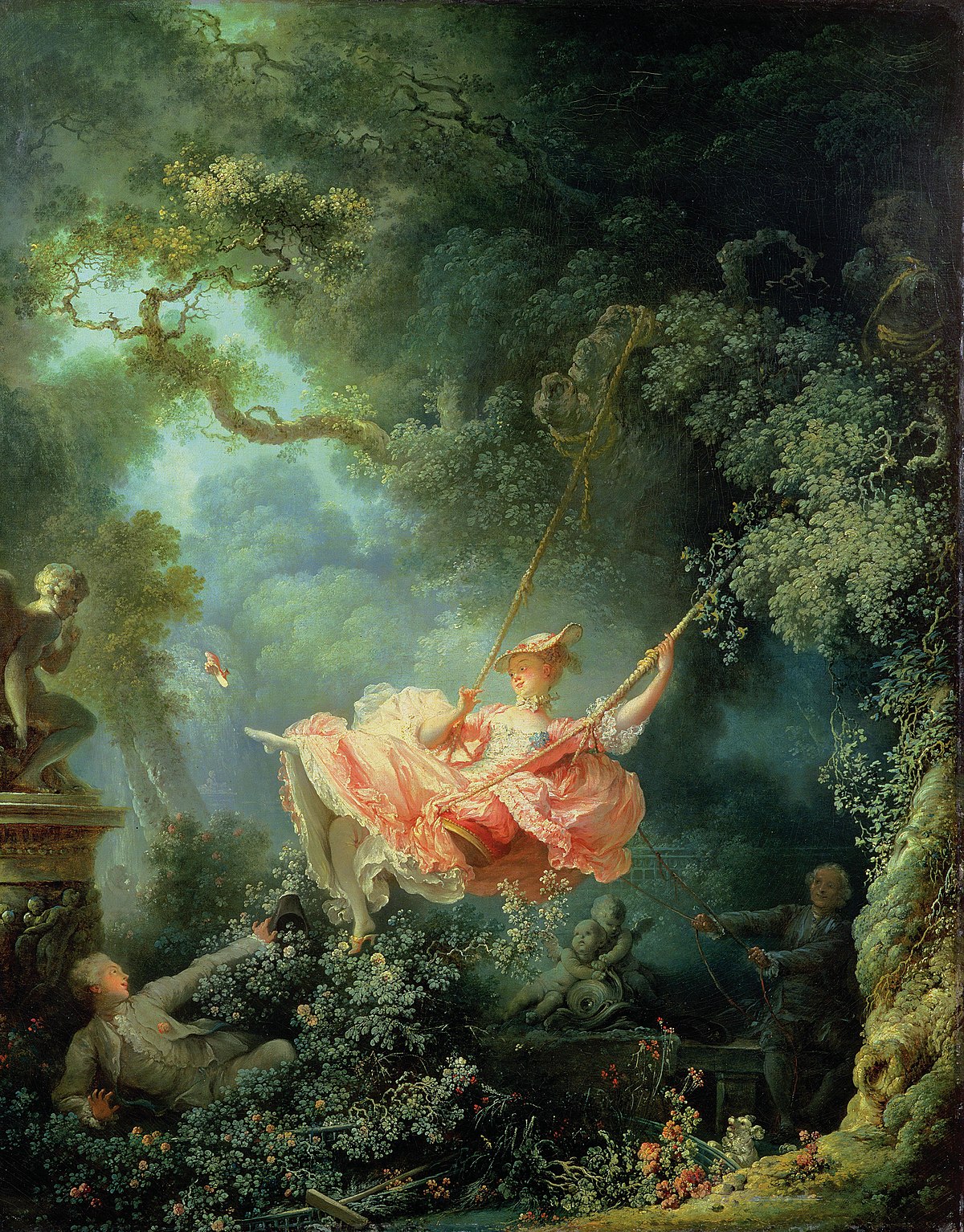
➼ Still Life in Studio
Details
- By Louis-Jacques-Mande Daguerre
- 1837
- Daguerreotype
- French Photographic Society, Paris
Form
- Photograph reproduces a variety of textures: fabric, wicker, plaster, framed print, etc.
- Inspired by painted still lifes, such as vanitas paintings.
Context
- New art form proclaimed while referencing older art forms.
- Daguerreotypes have a shiny surface and a sharp eye for detail.
- No negative; therefore, copies could not be made.
- Long exposure times required.
- Produced on a metallic surface; photos have a glossy finish.
➼ Starry Night
Details
- By Vincent van Gogh
- 1889
- Oil on canvas
- Found in Museum of Modern Art, New York
Form
- Thick, short brushstrokes.
- Heavy application of paint called impasto.
- Parts of the canvas can be seen through the brushwork; artist need not fill in every part of the surface.
- Strong left-to-right wave-like impulse in the work broken only by the tree and the church steeple.
- The tree looks like green flames reaching into a sky that is exploding with stars over a placid village.
Context
- The mountains in the distance are the ones that Van Gogh could see from his hospital room in Saint-Rémy; steepness exaggerated.
- Combination of images: Dutch church, crescent moon, Mediterranean cypress tree.
- Cypresses were often associated with cemeteries.
- Landscape painting was popular in the late nineteenth century as a reaction to the industrialization of cities.
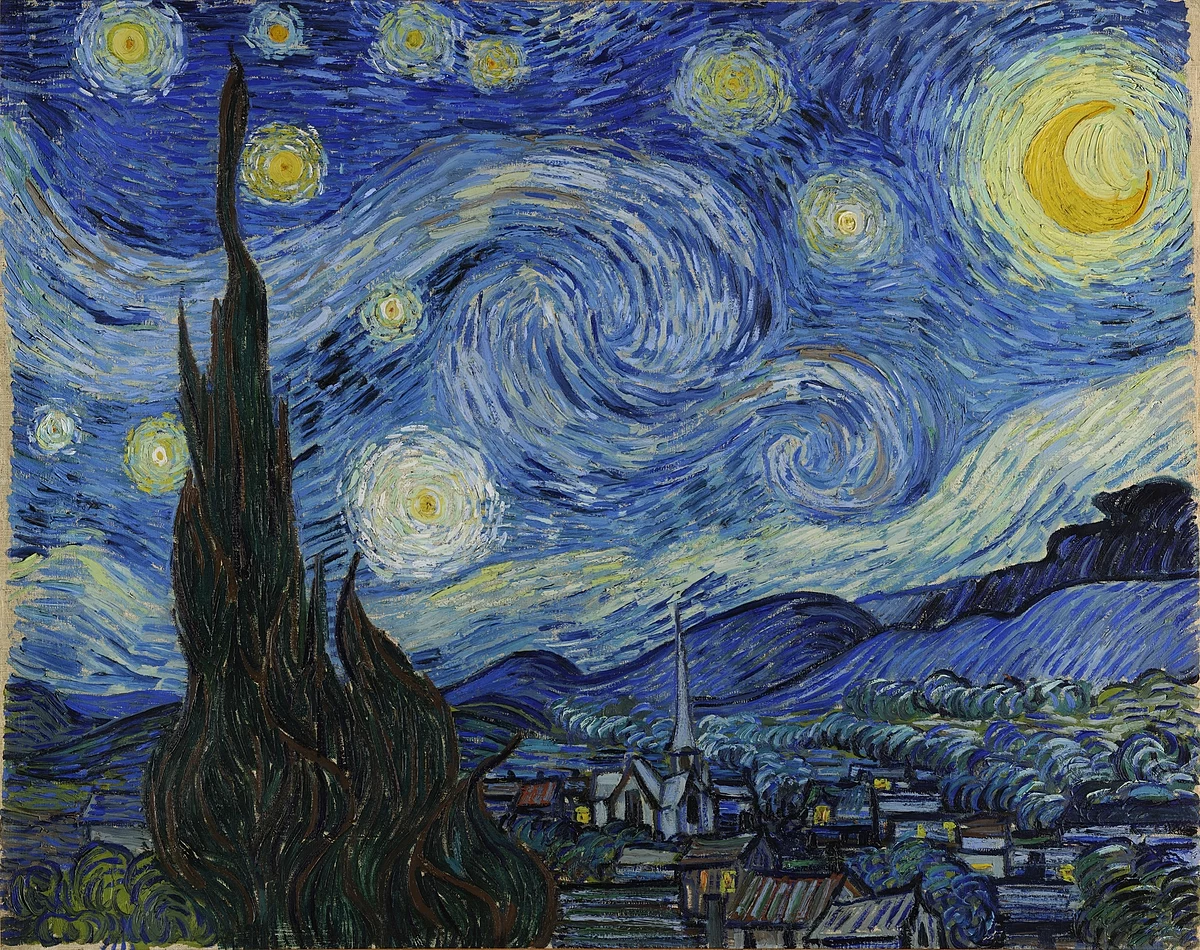
➼ The Scream
Details
- By Edvard Munch
- 1893
- Tempera and pastels on cardboard
- Found in National Gallery, Oslo
Form and Content
- The figure walks along a wharf; boats are at sea in the distance.
- Long, thick brushstrokes swirl around the composition.
- The figure cries out in a horrifying scream; the landscape echoes his emotions.
- Discordant colors symbolize anguish.
- Emaciated, twisting stick figure with skull-like head.
Function: Painted as part of a series called The Frieze of Life; a semi autobiographical succession of paintings.
Context
- Said to have been inspired by an exhibit of a Peruvian mummy in Paris.
- The work prefigures Expressionist art.
- The work is influenced by Art Nouveau swirling patterns.
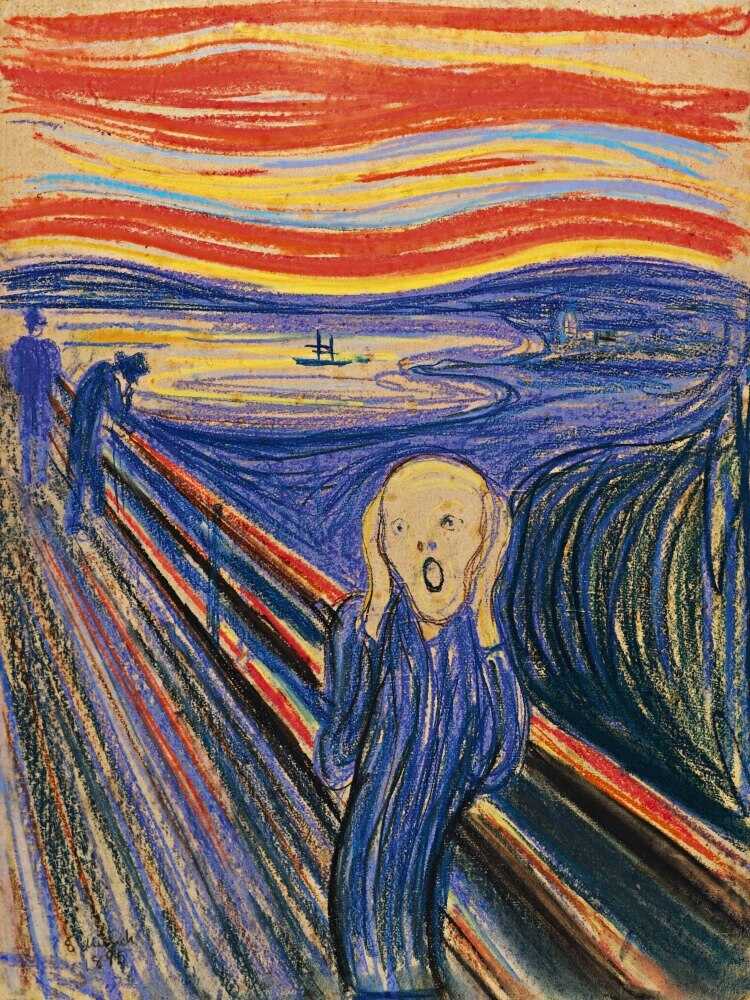
➼ The Kiss
Details
- By Gustav Klimt
- 1907–1908
- Oil and gold leaf on canvas
- Found in Austrian Gallery, Vienna
Form
- Little of the human form is actually seen: two heads four hands, two feet.
- The bodies are suggested under a sea of richly designed patterning.
- The work is spaced in an indeterminate location against a flattened background.
Context
- The male figure is composed of large rectangular boxes; the female figure is composed of circular forms.
- The work suggests all-consuming love; passion; eroticism.
- The use of gold leaf is reminiscent of Byzantine mosaics
- The work is influenced by gold applied to medieval illuminated manuscripts.
- Part of a movement called the Vienna Succession, which broke away from academic training in schools at that time.
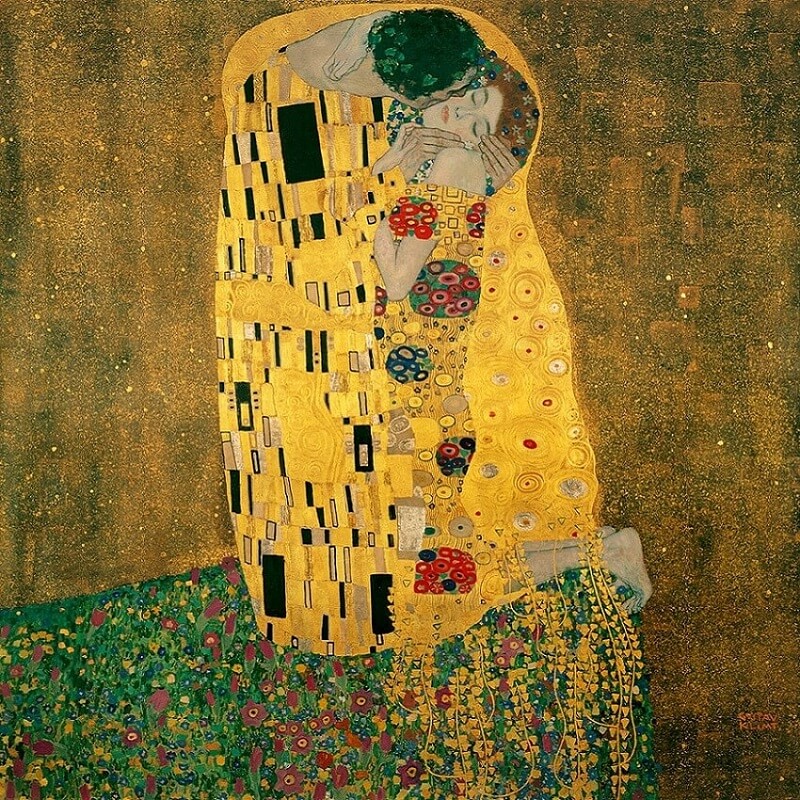
➼ Louis Sullivan, Carson, Pirie, Scott and Company Building
Details
- 1899–1903
- Iron, steel, glass, and terra cotta
- Found in Chicago
Form
- Horizontal emphasis on the exterior mirrors the continuous flow of floor space on the interior.
- The exterior is covered in decorative terra cotta tiles; original interior ornamentation elaborately arranged around lobby areas, hallways, elevator; interior ornamentation now lost.
- The architect designed maximum window areas to admit light, but also to make displays visible from the street.
- Nonsupportive role of exterior walls; held up by an interior framework.
- Open ground plan allows for free movement of customers and goods.
Function: A department store on a fashionable street in Chicago.
Context
- Some historical touches exist in the round entrance arches and the heavy cornice at the top of the building.
- Cast iron decorative elements transformed the store into a beautiful place to buy beautiful things.
- Shows the influence of Art Nouveau in decorative ironwork on the entrance.
- Sullivan motto: “Form follows function.”
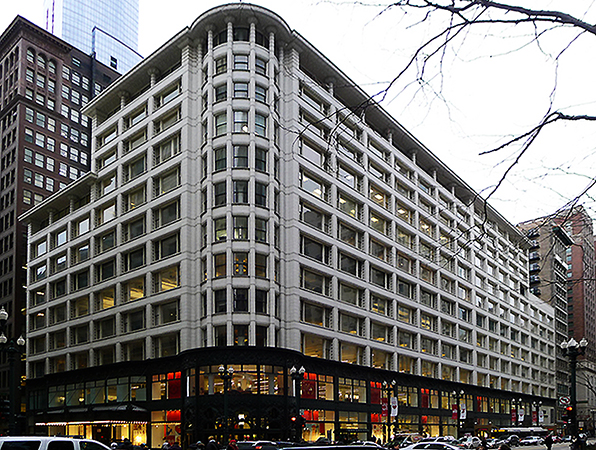
➼ Goldfish
Details
- By Henri Matisse
- 1912
- Oil on canvas
- Formerly in Pushkin Museum of Art, Moscow, Russia
Form
- Strong contrasts of color.
- Thinly applied colors; the white of the canvas shows through.
- Energetic, painterly brushwork.
- Broad patches of color anticipate color-field painting later in the century.
Content
- Still-life painting.
- Compare to Ruysch, Fruits and Insects, and Daguerre, Still Life in Studio.
Context
- May have been in response to a trip in Morocco, where Matisse noted how the local population would daydream for hours, gazing into goldfish bowls. Form, color, and subject matter were inspired by this trip.
- Admired the relaxed and contemplative lifestyle of the Moroccans, which symbolized a meditative state of mind and a sense of paradise lost to Europeans.
- May have been influenced by the decorative quality of Asian art and diverse cultures from North Africa.
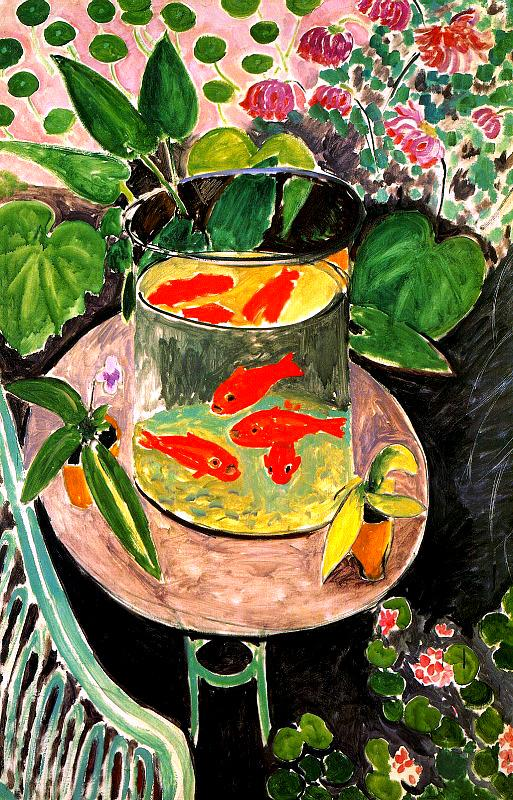
➼ Improvisation 28 (2nd Version)
Details
- By Vassily Kandinsky
- 1912
- Oil on canvas
- Found in Guggenheim Museum, New York
Form
- Strongly articulated use of black lines.
- Colors seem to shade around line forms.
Content
- Using schematic means, Kandinsky depicts cataclysmic events on the left (boat and waves—a deluge, a serpent, a cannon) and a sense of spiritual salvation on the right (a couple embrace, a candle, a church on a hill).
Context
- Kandinsky wanted the viewer to respond to a painting the way one would to an abstract musical composition: a concerto, a sonata, a symphony.
- The artist felt that sound and color were linked; for example, it was possible to hear color.
- He used words such as “composition” and “improvisation” in the titles of his works, words associated with musical composition.
- Kandinsky’s works have a relationship to atonal music, which was evolving at this time.
- Movement toward abstraction; representational objects suggested rather than depicted.
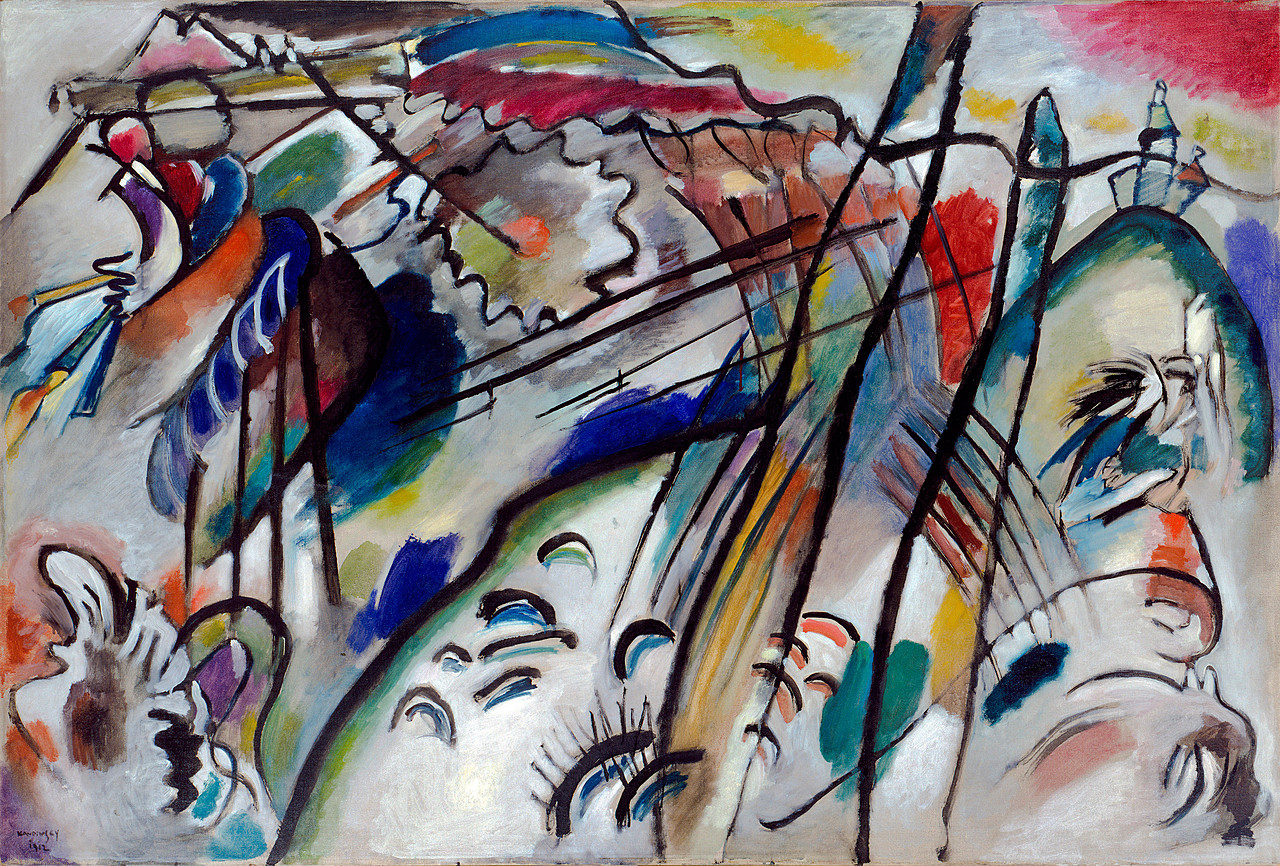
➼ Self-Portrait as a Soldier
Details
- By Ernst Ludwig Kirchner
- 1915
- Oil on canvas
- Found in Allen Memorial Art Museum, Oberlin College, Oberlin, Ohio
Form
- Nightmarish quality.
- Colors are nonrepresentational but symbolic, chosen to provide a jarring impact. Expressive quality of horrified facial features and grim surroundings.
- Tilted perspective moves things closer to the picture plane.
- Main figure has a drawn face, with a cigarette hanging loosely from his lips.
- The eyes are unseeing and empty, without pupils; the iris reflects the blue of his uniform.
- The bloody stump of a hand represents losses in war, loss of the artist’s ability to paint, his creativity, his artistic vision, and his inspiration.
- Sharp angular lines reinforce a sense of violence and anxiety.
Context
- Kirchner became an “unwilling volunteer,” a driver in the artillery in World War I, to avoid being drafted into the infantry.
- He is wearing the uniform of his field artillery regiment.
- He was declared unfit for service; he had lung problems and weakness and suffered a mental breakdown—there is scholarly debate as to whether he faked these ailments to avoid service.
- This self-portrait was painted during a recuperation period.
- His life was plagued by drug abuse, alcoholism, and then paralysis.
- The artist feared that war would destroy his creative powers.

➼ Memorial Sheet for Karl Liebknecht
Details
- By Käthe Kollwitz
- 1919–1920
- Woodcut
- A Private Collection
Form
- Stark black and white of the woodcut used to magnify the grief.
- Human grief dominates.
Patronage: Family of Liebknecht asked Kollwitz to memorialize him.
Technique
- Wood-block print.
- Kollwitz used this technique to reinforce the emotions depicted in the scene.
- She liked the “primitive” quality that wood-block prints could render.
Context
- Liebknecht was among the founders of the Berlin Spartacus League, which became the German Communist Party.
- In 1919, Liebknecht was shot to death during a Communist uprising in Berlin called the Spartacus Revolt (named for the slave who led a revolt against the Romans in 73 B.C.E.).
- Liebknecht was held to be a martyr in the Communist cause.
- There are no political references in the woodcut.
- Themes of war and poverty dominate the artist’s oeuvre.
- She often emphasized the theme of women grieving over dead children; her son died in World War I; the artist then became a socialist.

➼ Les Demoiselles d’Avignon
Details
- By Pablo Picasso
- 1907
- Oil on canvas
- Found in Museum of Modern Art, New York
Content
- Depicts five prostitutes in a bordello in Avignon Street in Barcelona, each posing for a customer.
- Poses are not traditionally alluring but awkward, expressionless, and uninviting.
Form
- The three on the left are more conservatively painted; the two on right more radical; reflects a dichotomy in Picasso.
- Multiple views are expressed at the same time.
- Depth is limited, but ambiguous and ever shifting.
- The painting has semitransparent passages.
Context
- This is the first cubist work, influenced by late Cézanne and perhaps African masks (faces on the right) and ancient Iberian sculpture (figure on the left).
- Influenced by Gauguin’s so-called Primitivism.
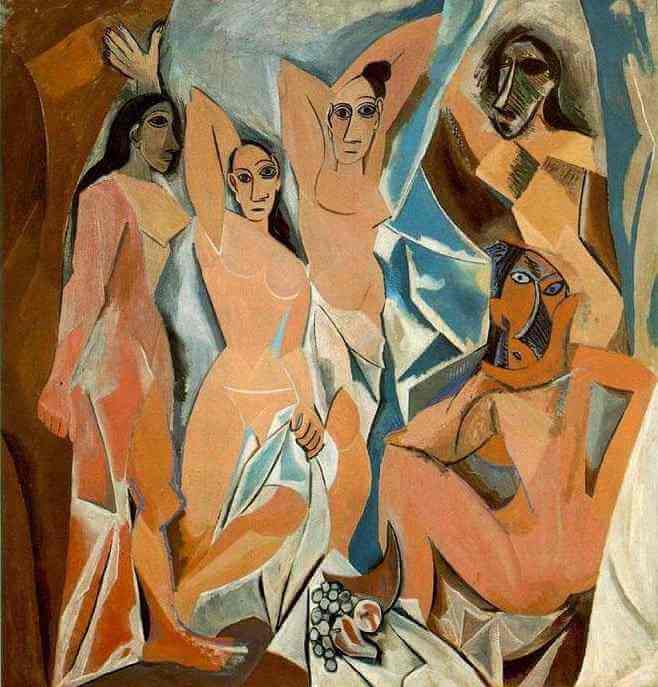
➼ The Portuguese
Details
- By Georges Braque
- 1911
- Oil on canvas
- Art Museum, Basel, Switzerland
Form
- Braque rejected naturalistic and conventional painting.
- Fractured forms; breaking down of objects into smaller forms.
- Clear-edged surfaces at the front of the picture plane, not recessed in space.
- Nearly monochrome.
Context
- Analytical Cubism; Braque worked in concert with Pablo Picasso to develop this style.
- This is not a portrait of a Portuguese musician, but rather an exploration of shapes.
- The only realistic elements are the stenciled letters and numbers; perhaps they suggest a dance hall poster behind the guitarist, a café-like atmosphere.
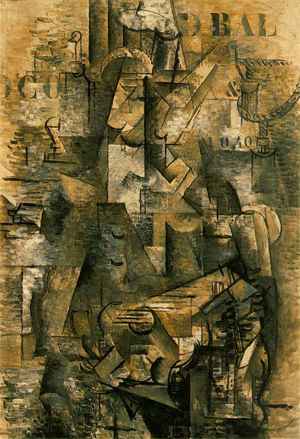
➼ The Steerage
Details
- By Alfred Stieglitz
- 1907
- photogravure
- A private collection
Form
- Interested in compositional possibilities of diagonals and lines acting as framing elements.
- Diagonals and framing effects of ladders, sails, steam pipes, etc.
- Stieglitz photographed the world as he saw it; he arranged little, and allowed people and events to make their own compositions.
- Influenced by experimental European painting; compared with a Cubist drawing by Picasso, Cubist-like in arrangement of shapes and tonal values.
Content
- Steerage: the part of a ship reserved for passengers with the cheapest tickets.
- Depicts the poorest passengers on a ship traveling from the United States to Europe in 1907; they were allowed out for air for a limited time.
- Some may have been people turned away from entrance to the United States; more likely, they were artisans whose visas had expired and were returning home.
Context
- The work depicts social divisions in society.
- Published in October 1911 in Camera Work.
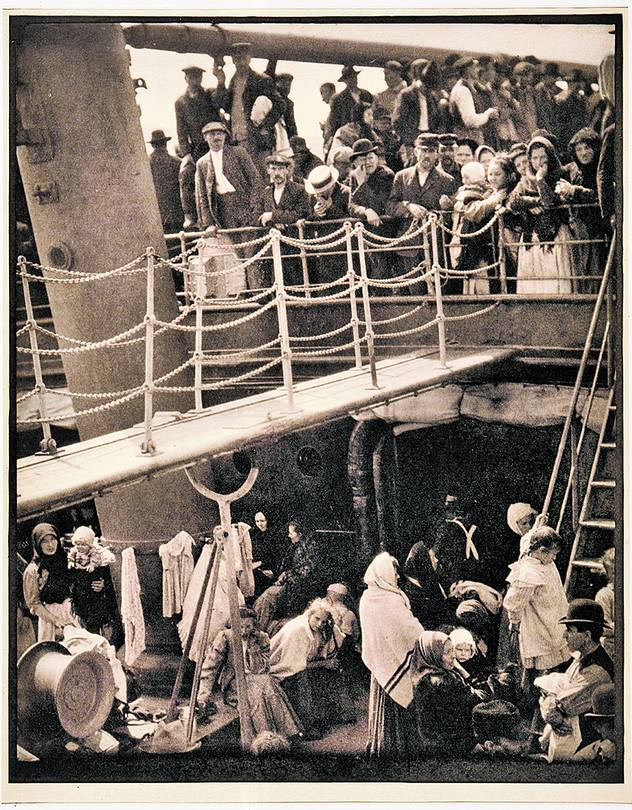
➼ Fountain
- Details
- By Marcel Duchamp
- Originally 1917; this version is 1950
- readymade glazed sanitary china with black paint
- Found in Philadelphia Museum of Art, Pennsylvania
- Form
- Ready-made sculpture; actually a found object that Duchamp deemed to be a work of art.
- Signed by the “artist,” R. Mutt, a pun on the Mutt and Jeff comic strip and Mott Iron Works.
- Item purchased from a sanitary-ware supplier and submitted to the Society of Independent Artists, a group that Duchamp helped to found.
- Function and History
- Entered in an unjuried show, the work was refused—narrowly voted out by the organizers.
- Thought to be indecent, not fit to show women.
- Duchamp resigned in protest.
- It is not fully understood why Duchamp resigned; it may have come from his experience exhibiting an earlier work Nude Descending a Staircase No. 2 to the Salon des Indépendants in Paris; although the work was illustrated in the show’s catalog, Duchamp was asked to remove it a few days before the opening.
- He removed the object but felt betrayed; said it was a turning point in his life.
- Fountain can be seen as an experimental replay by Duchamp, testing the commitment of the new American Society to freedom of expression and tolerance of new conceptions about art.
- Context
- The title is a pun: a fountain spouts liquid, a urinal collects it.
- The placing of the urinal upside down is an added irony.
- The rotation of Fountain may symbolize seeing something familiar from a new perspective.
- The original is now lost; Duchamp oversaw the “remaking” of a few models in 1964.
➼ Object (Le Dejéuner en fourrure)
Details
- By Meret Oppenheim
- 1936
- fur-covered cup, saucer, and spoon
- Found in Museum of Modern Art, New York
Form: An assemblage.
Context
- Said to have been done in response to Picasso’s claim that anything looks good in fur; Oppenheim said to respond, “Even this cup and saucer?”
- Erotic overtones.
- Combination of unalike objects: fur-covered teacup, saucer, and spoon. The tea cup was purchased at a department store; the fur is the pelt of a Chinese gazelle.
- A contrast of textures: fur delights the touch, not the taste; cups and spoons are meant to be put in the mouth.
- Oppenheim did not title the work, but the Surrealist critic, Andre Breton, called the piece Le Déjeneur en fourrure, or Luncheon in Fur, a title that references Édouard Manet’s Luncheon on the Grass as well as the erotic novel by Leopold von Sacher-Masoch called Venus in Furs.
- Chosen by visitors to a Surrealist show in New York as the quintessential Surrealist work of art.
- Because fame came to Oppenheim so young (she was twenty-two when she produced this work), it inhibited her growth as an artist.
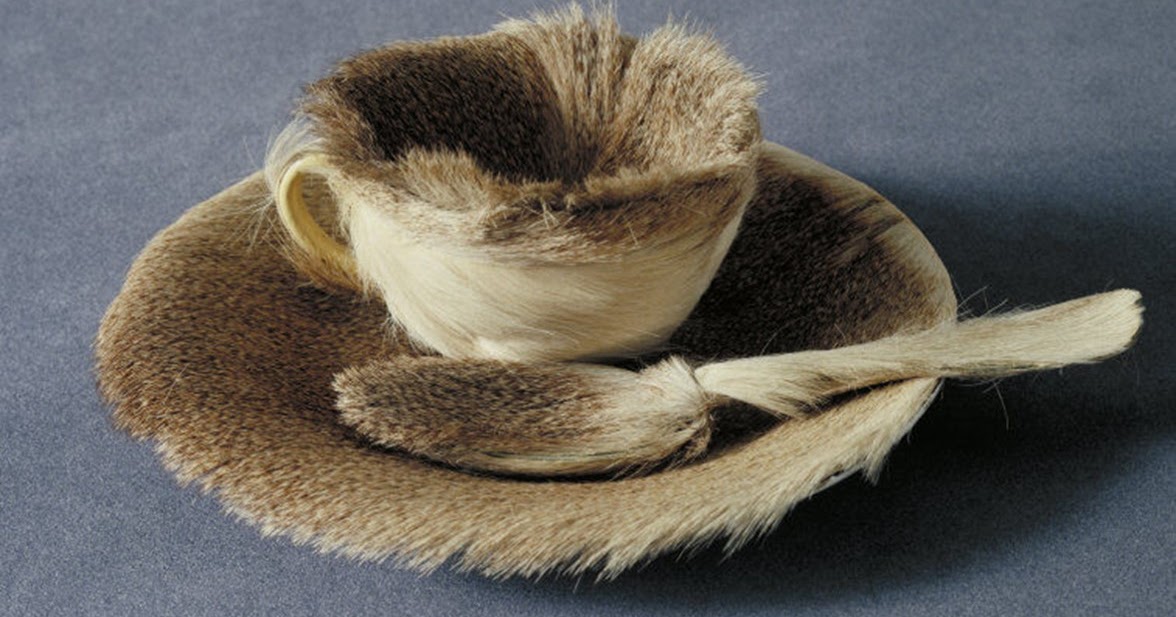
➼ The Two Fridas
Details
- By Frida Kahlo
- 1939
- oil on canvas
- Found in Museum of Modern Art, Mexico City
Content
- On the left: Kahlo is dressed as a Spanish lady in white lace, linking her to a European heritage.
- On the right: Kahlo dressed as a Mexican peasant—the stiffness and provincial quality of Mexican folk art was a direct inspiration for the artist.
- Behind is a barren landscape; two figures sit against a wildly active sky.
Context
- There is a juxtaposition to two self-portraits.
- Kahlo’s two hearts are joined together by veins that are cut by scissors at one end and lead to a portrait of her husband, artist Diego Rivera, at the other; painted at the time of their divorce.
- The vein acts as an umbilical cord; symbolism: Rivera as both husband and son.
- Blood on her lap suggests many abortions and miscarriages; also, surgeries related to her health issues.
- Kahlo rejected the label Surrealism for her artwork.
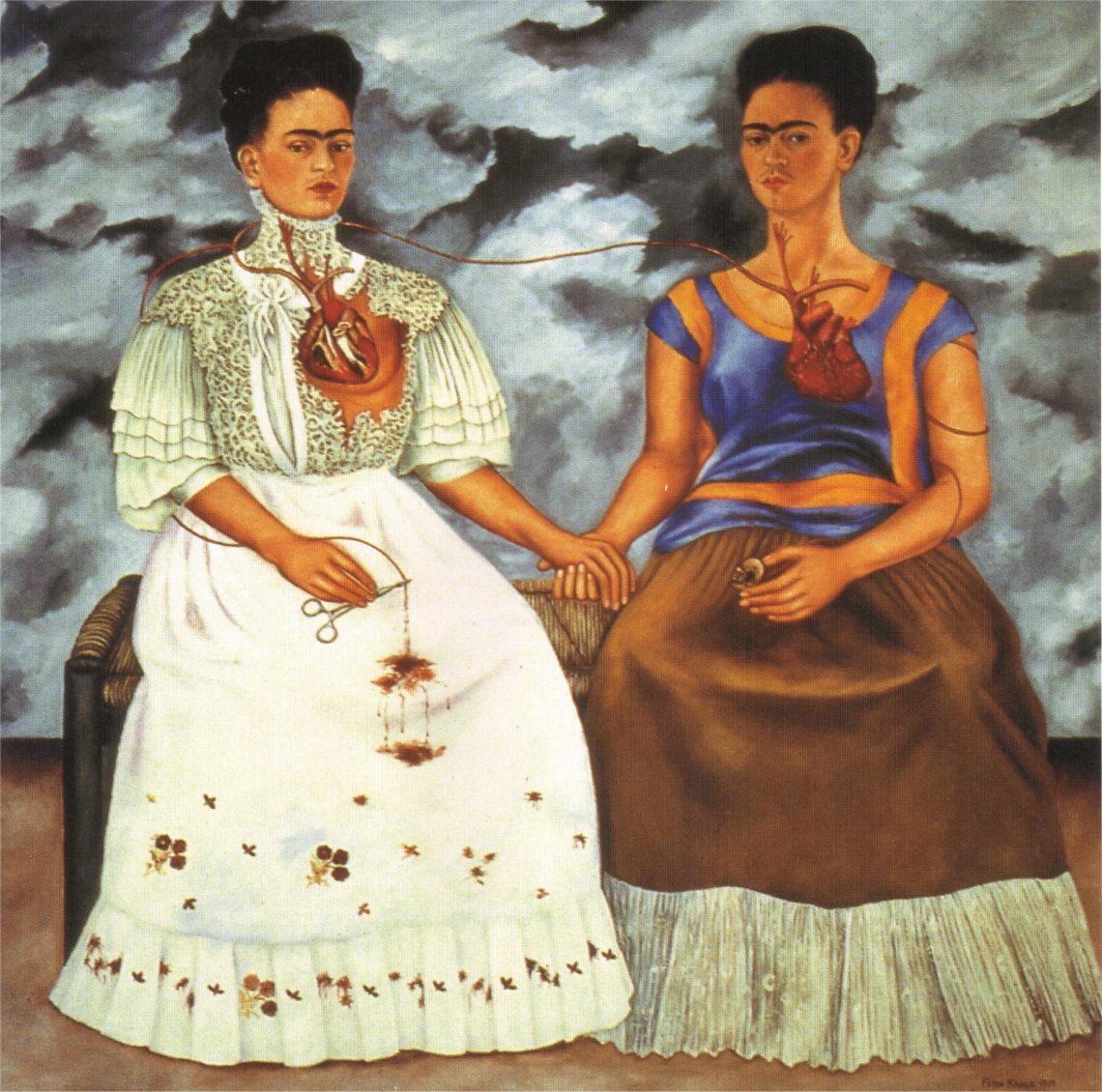
➼ The Jungle
Details
- By Wifredo Lam
- 1943
- gouache on paper mounted on canvas
- Found in Museum of Modern Art, New York
Form
- Crescent-shaped faces suggest African masks and the god Elegua.
- Rounded backs, thin arms and legs, pronounced hands and feet.
- Long vertical lines suggest sugarcane, which is grown in fields, not jungles.
Context
- Cuban-born artist whose career took him to Europe and the United States.
- The artist was interested in Cuba’s mixture of Hispanic and African cultures.
- This work was “intended to communicate a psychic state.”
- The work addresses the history of slavery in colonial Cuba.
- Influences include African sculpture; Cubist works; Surrealist paintings (Lam was a member of the Surrealist movement in Paris).
- The painting contrasts a Cuban landscape with a tourist image of Cuba as a tropical paradise.
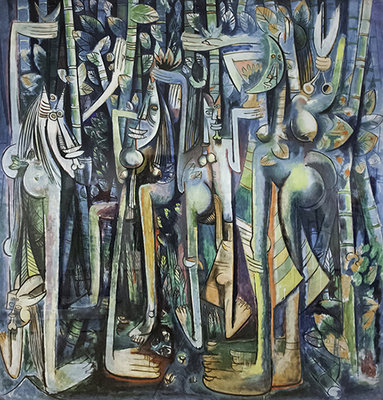
➼ Illustration from The Results of the First Five-Year Plan
Details
- By Varvara Stepanova
- 1932
- photomontage
- Found in Museum of the Revolution, Moscow, Russia
Form and Function
- Graphic art for political and propaganda purposes; a photomontage.
- Red color dominates—the color of Communist Soviet Union.
- A large portrait of Lenin dominates; although deceased, his image is used to stimulate patriotism.
- Masses of people below illustrate the popularity of the Five-Year Plan.
- CCCP (Союз Советских Социалистических Республи) is a Russian abbreviation for the Soviet Union.
Context
- Stepanova was one of the main figures in the Russian avant-garde movement.
- Influenced by Cubism and Futurism.
- Five-Year Plan:
- Soviet practice of increasing agricultural and industrial output in five years.
- Launched in 1928, considered complete in 1932.
- Emphasis on growth of heavy industry rather than consumer goods.
- Huge increases in electrical output (dominant industrial symbol in the work).
- The failures of the five-year plan are overlooked in this representation (famine, extreme poverty, political oppression); instead it is a propaganda statement of the virtues of the Stalinist state.
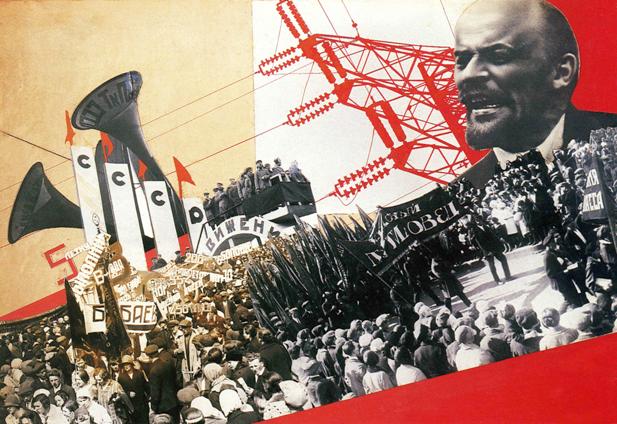
➼ Composition with Red, Blue and Yellow
Details
- By Piet Mondrian
- 1930
- oil on canvas
- Found in Kunsthaus,Zurich
Form
- Only primary colors used—red, yellow, and blue—plus the neutral colors, white and black.
- Severe geometry of form; only right angles; grid-like forms.
- No shading of colors.
Context
- The artist is interested in the material properties of paint, not naturalistic depictions.
- The artist expresses ideas using abstract elements—that is, line and color.
- Influenced by Cubism.
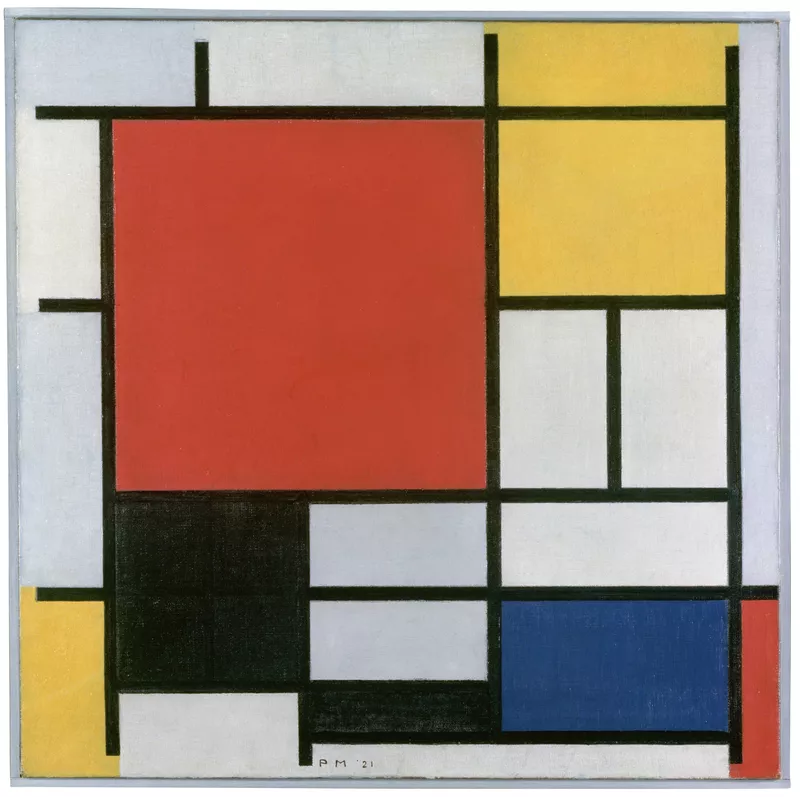
➼ Fallingwater
Details
- By Frank Lloyd Wright
- 1936–1939
- reinforced concrete, sandstone, steel, and glass
- Found in Bear Run, Pennsylvania
Form
- Cantilevered steel-supported porches extend over a waterfall.
- The accent is on horizontal lines—as opposed to the verticality of much of twentieth-century architecture.
- The architecture is in harmony with the site.
- The living room contains a glass curtain wall around three of the four sides; the building embraces the woods around it.
- The floor of the living room and the walls of building are made from the stone of the area.
- The hearth (physically and symbolically) is the center of the house, an outcropping of natural stones surrounds it.
- The interior shows a suppression of space devoted to hanging a painting; Wright wanted the architecture to dominate.
- The ground plan and design is irregular and complex.
- Only two colors used: light ochre for the concrete and Cherokee red for the steel.
Context: Late expression of Prairie School ideas.
Function and Patronage: Weekend retreat for the Kaufmann family, who owned a department store in Pittsburgh, Pennsylvania.
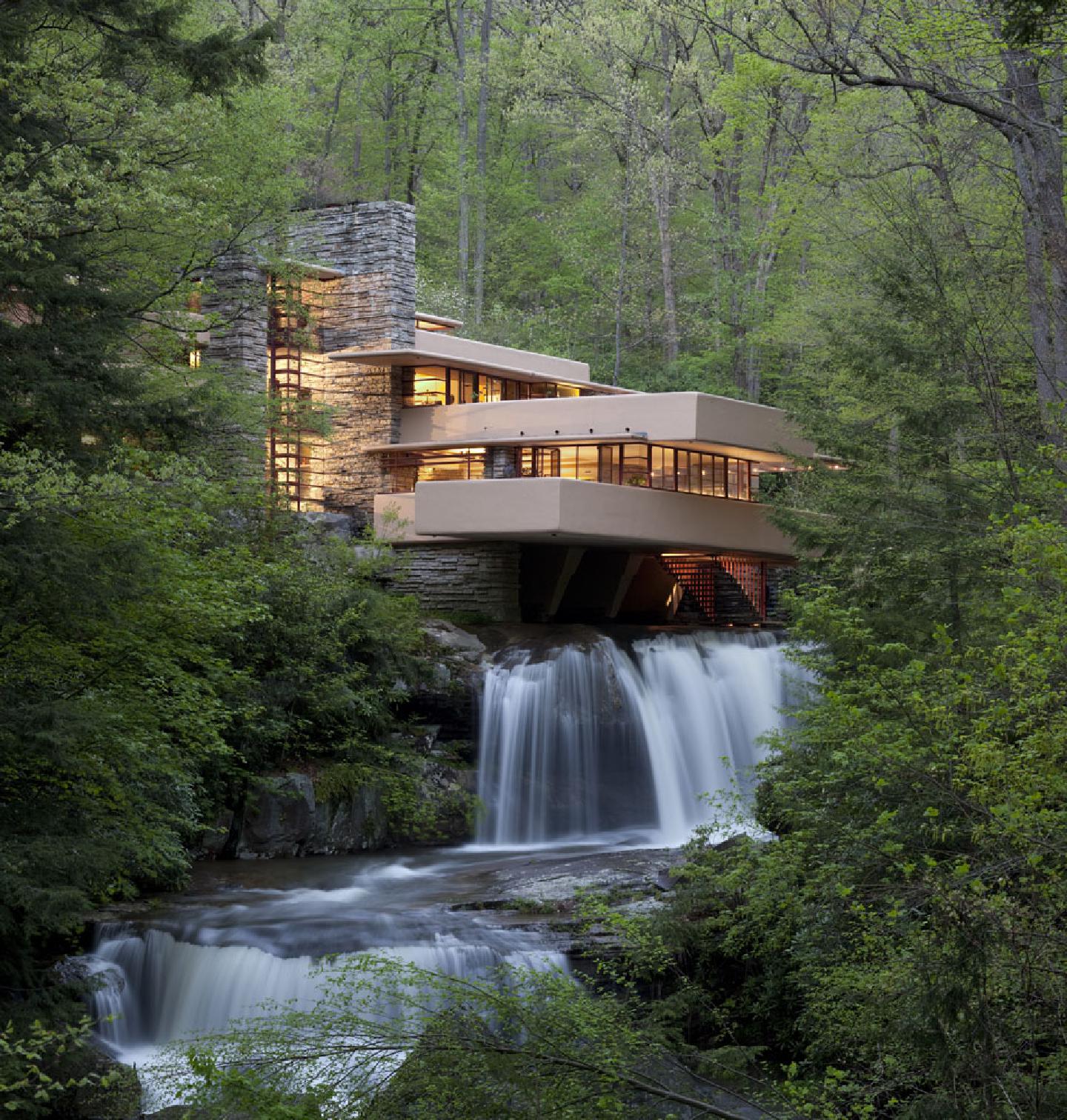
➼ Villa Savoye
Details
- By Le Corbusier
- 1929
- steel and reinforced concrete
- Found in Poissy-sur-Seine, France
Form
- Boxlike horizontal quality; an abstraction of a house.
- The main part of the house is lifted off the ground by narrow pilotis—thin freestanding posts.
- The house appears to float on pilotis; allows air to circulate around the base of the house.
- The turning circular carport on the bottom floor enables family members to enter the house directly from their car.
- All space is utilized, including the roof, which acts as a patio.
- The roof terraces bring the outdoors into the house.
- Subtle colors: white on exterior symbolizes modern cleanliness and healthful living.
- Open interior is free of many walls.
- Some furniture is built into the walls.
- Ribbon windows wind around the second floor.
- Streamlined look.
- Living spaces that are surrounded by glass face an open courtyard-type setting on the second floor.
Function and Patronage
- A three-bedroom country house with servants’ quarters on the ground floor.
- Built in suburban Paris as a retreat for the wealthy.
- Patrons: Pierre and Emilie Savoye.
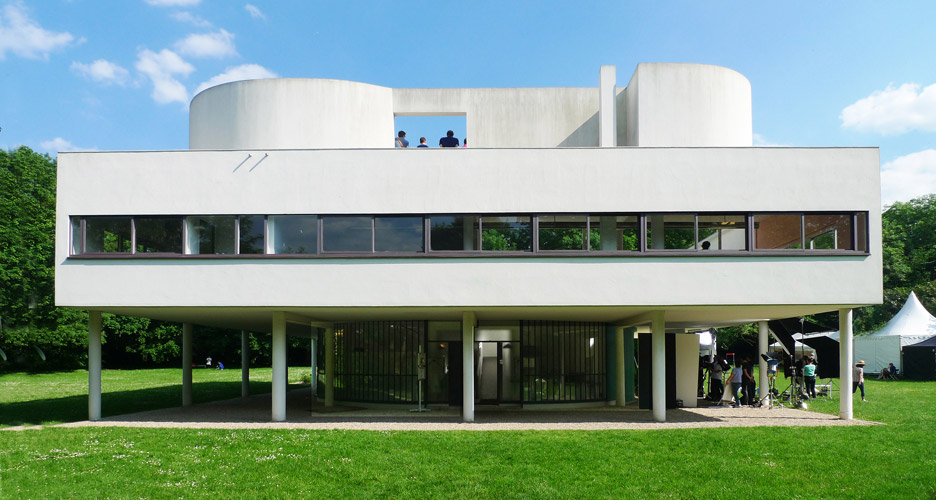
➼ Seagram Building
Details
- By Ludwig Mies van der Rohe and Philip Johnson
- 1954–1958
- steel frame with glass curtain wall and bronze
- Found in New York
Function: 38-story corporate headquarters of the Seagram Liquor Company.
Form
- Bronze veneer gives the skyscraper a monolithic look; bronze is maintained yearly to keep the same color.
- Set back from Park Avenue on a wide plaza balanced by reflecting pools.
- Interplay of vertical and horizontal accents.
- Mullions stress the verticality of the internal frame.
Context
- Minimalist architecture.
- Monolith style expresses corporate power.
- Mies’s saying of “Less is more” can be seen in this building with its great simplicity, geometry of design, and elegance of construction.
- Mies also said, “God is in the details;” truthful buildings express their structure, not hide it.
- Steel and glass skyscrapers and curtain wall construction became the model after World War II.
- A triumph of the International Style of architecture.
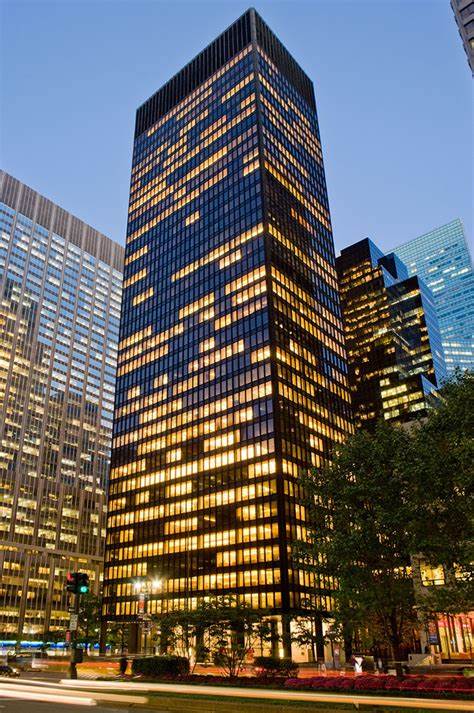
➼ The Migration of the Negro, Panel no. 49
Details
- By Jacob Lawrence
- 1940–1941
- casein tempera on hardboard
- Found in Museum of Modern Art, New York
Form
- The work illustrates the collective African-American experience; therefore, there is little individuality in the figures.
- Forms hover in large spaces.
- Angularity of forms.
- Tilted tabletops show the surface of the table.
- Flat, simple shapes.
- Unmodulated colors.
- Collective unity achieved by painting one color across many panels before going on to the next color; overall color unity in the series unites each painting.
Content
- This scene involves a public restaurant in the North; segregation emphasized by the yellow poles that zigzag down the center.
- Whites appear haughty and self-engrossed.
- African-Americans appear faceless; forms reveal their bodies and personalities.
Context
- One of a series of 60 paintings that depicts the migration of African-Americans from the rural South to the urban North after World War I.
- Negroes escaping the economic privation of the South.
- Narrative painting in an era of increasing abstraction.
- Cinematic movement of views of panels: some horizontal and others vertical.
- Influenced by the Italian masters of the fourteenth and fifteenth centuries; used tempera paint.
- The Phillips Collections in Washington, D.C., and the Museum of Modern Art in New York bought the collection and it was split.
- The Phillips took the odd-numbered paintings; the Museum of Modern Art has the even-numbered ones.

➼ Dream of a Sunday Afternoon in the Alameda Park
Details
- By Diego Rivera
- 1947–1948
- fresco
- Found in Museo Mural Diego Rivera, Mexico City
Form
- 50-foot-long fresco, 13 feet high.
- Horror vacui; didactic painting.
- Colorful painting.
- Revival of fresco painting, a Mexican specialty.
Placement
- Originally in the lobby of the Hotel del Prado.
- After a 1985 earthquake destabilized the hotel, the fresco was placed in a museum adjacent to Alameda Park, Mexico City’s first city park—built on the grounds of an Aztec marketplace.
Content
- Three eras of Mexican history depicted from left to right:
- Conquest and colonization of Mexico by the Spanish.
- Porfirio Diaz dictatorship.
- Revolution of 1910 and the modern world.
- Depicts a who’s who of Mexican politics, culture, and leadership:
- Sor Juana, in nun’s habit, at left center.
- Benito Juárez, five-term president of Mexico, left at top.
- General Santa Ana handing the keys of Mexico to General Winfield Scott.
- Emperor Maximilian and Empress Carlota.
- José Marti, father of Mexican independence (tipping his hat).
- General Porfirio Díaz, with medals, asleep.
- A police officer ordering a family out of an elitist park.
- Francisco Madero, a martyred president.
- José Posaro, artist and Rivera hero.
- Rivera is in the center, at age ten, holding hands with Caterina (“Death”) and dreaming of a perfect love (Kahlo is behind him holding a yin/yang symbol—a symbol of Kahlo and Rivera’s relationship).

➼ Woman I
Details
- By Willem de Kooning
- 1950–1952
- oil on canvas
- Found in Museum of Modern Art, New York
Form
- Ferocious woman with great fierce teeth and huge eyes.
- Large, bulbous breasts satirize women who appear in magazine advertising; smile said to be influenced by an ad of a woman selling Camel cigarettes.
- Jagged lines create an overpowering image.
- The smile is a cut out of a female smile from a magazine advertisement.
- Blank stare; frozen grin.
- Ambiguous environment: vagueness, insecurity.
- Thick and thin black lines dominate.
Context
- Combination of stereotypes; ironic comment on the banal and artificial world of film and advertising.
- Commentary on the female form in art history.
- Is she aggressive? Or have aggressions been committed against her? Or both?
- One of a series of six paintings on this theme.
- Influenced by everything from paleolithic goddesses to pin-up girls
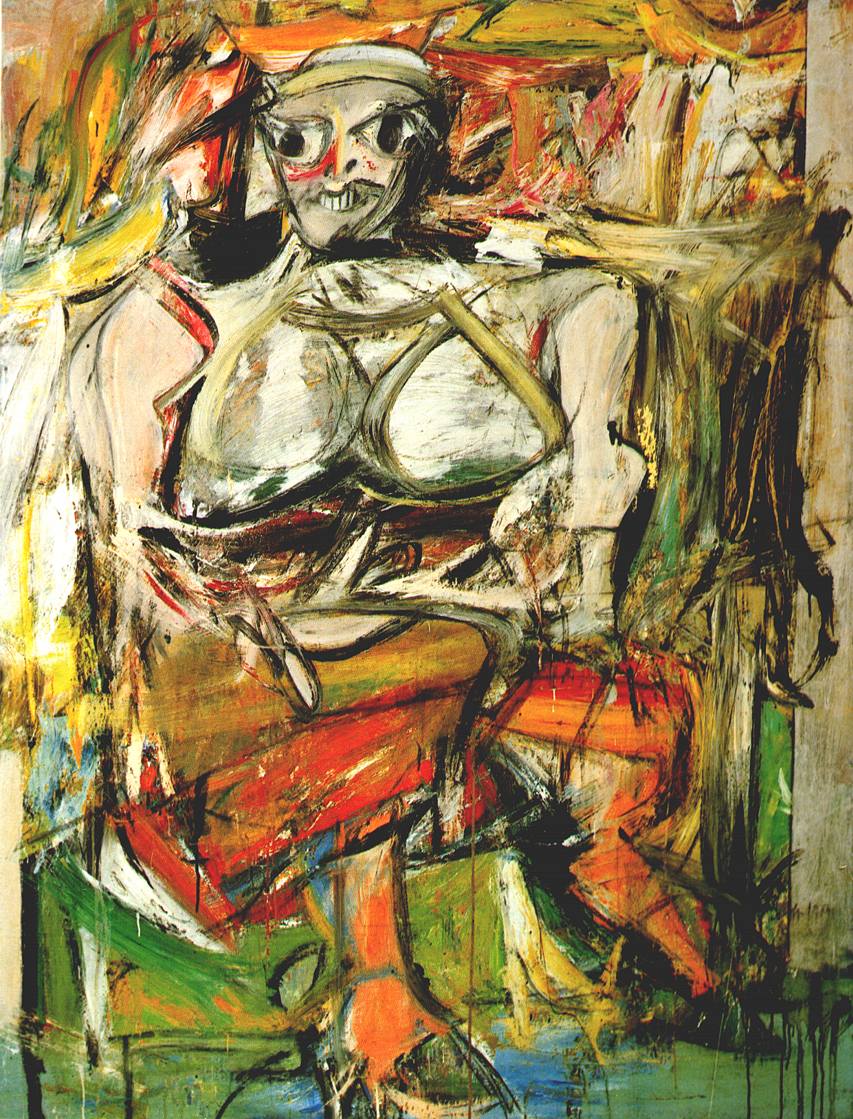
➼ The Bay
Details
- By Helen Frankenthaler
- 1963
- acrylic on canvas
- Found in Detroit Institute of Arts, Detroit, Michigan
Form
- Painted directly on an unprimed canvas; canvas absorbs the paint more directly.
- Use of runny water-based acrylic paint.
- Soak-stained technique.
- Use of landscape as a starting point, a basis for imagery in the works.
- The two-dimensionality of the canvas is accentuated.
Context and Interpretation: Artist worked in the avant-garde New York School at mid-century.
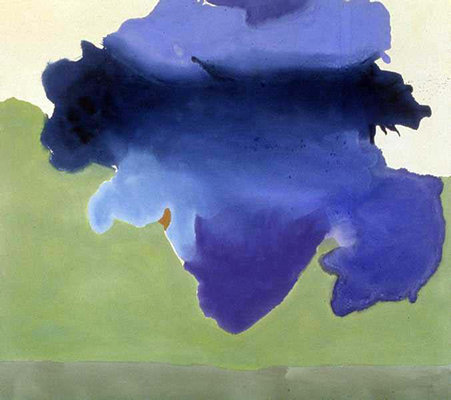
➼ Marilyn Diptych
Details
- By Andy Warhol
- 1962
- oil, acrylic, silkscreen enamel on canvas
- Found in Tate Gallery, London
Form and Content
- Marilyn Monroe’s public face appears sequentially as if on a roll of film.
- Fifty images from a film still from a movie, Niagara (1953).
- Social characteristics magnified: brilliance of blonde hair, heavily applied lipstick, seductive expression.
- Private persona of the individual submerged beneath the public face.
- Marilyn’s public face appears highlighted by bold, artificial colors.
- Left, in color, represents her in life; right, in black and white, represents her in death; work done four months after her tragic death.
- Repetition of faces reflects the repetition of the number of times Marilyn appeared before the public; sometimes overexposed, sometimes underexposed.
Materials and Technique
- Silkscreen printing technique applies photographic images in rectangular shapes onto a canvas background.
- Silkscreen diminishes the role of shading and emphasizes broad planes and unmodulated color.
- Diptych format suggests almost a religious presence.
Context
- Cult of celebrity; Monroe was a famous movie star of the 1950s.
- Private persona of Marilyn submerged beneath the public face(s).
- Repeated imagery drains the image of Monroe of meaning.
- Reproduction of many denies the concept of the unique work of art.
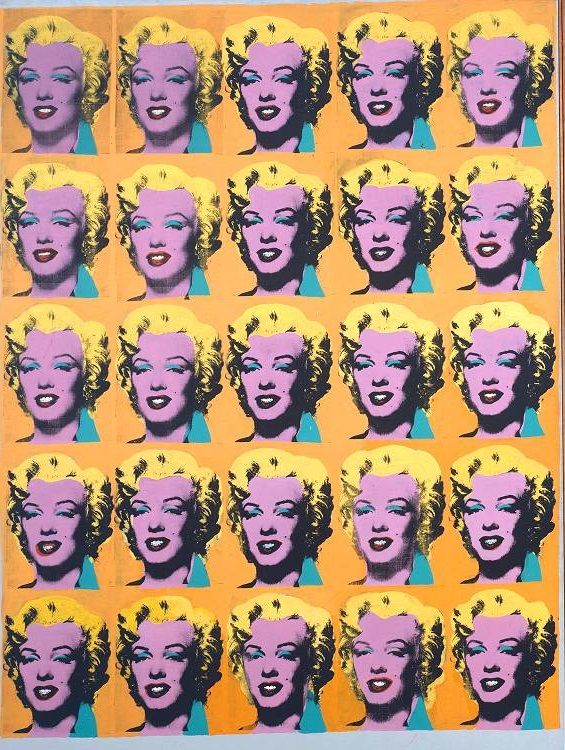
➼ Lipstick (Ascending) on Caterpillar Tracks
Details
- By Claes Oldenburg
- 1969–1974
- cor-ten steel, steel, aluminum, and cast resin, painted with polyurethane enamel
- Found in Yale University, New Haven, Connecticut
Function
- First installed, secretly, on Beinecke Plaza, New Haven, in 1969.
- Intended as a platform for public speakers; rallying point for anti-Vietnam-era protests.
Materials
- Sculpture made of inexpensive and perishable materials (plywood tracks and an inflatable vinyl balloon tip).
- Refurbished with steel and aluminum; reinstalled in 1974 in front of Morse College, at Yale—not its original location.
Context
- Tank-shaped platform base with lipstick ascending—antiwar symbolism.
- Male and female forms unite: themes of death, power, desire, and sensuality.
- First monumental sculpture by Oldenburg.
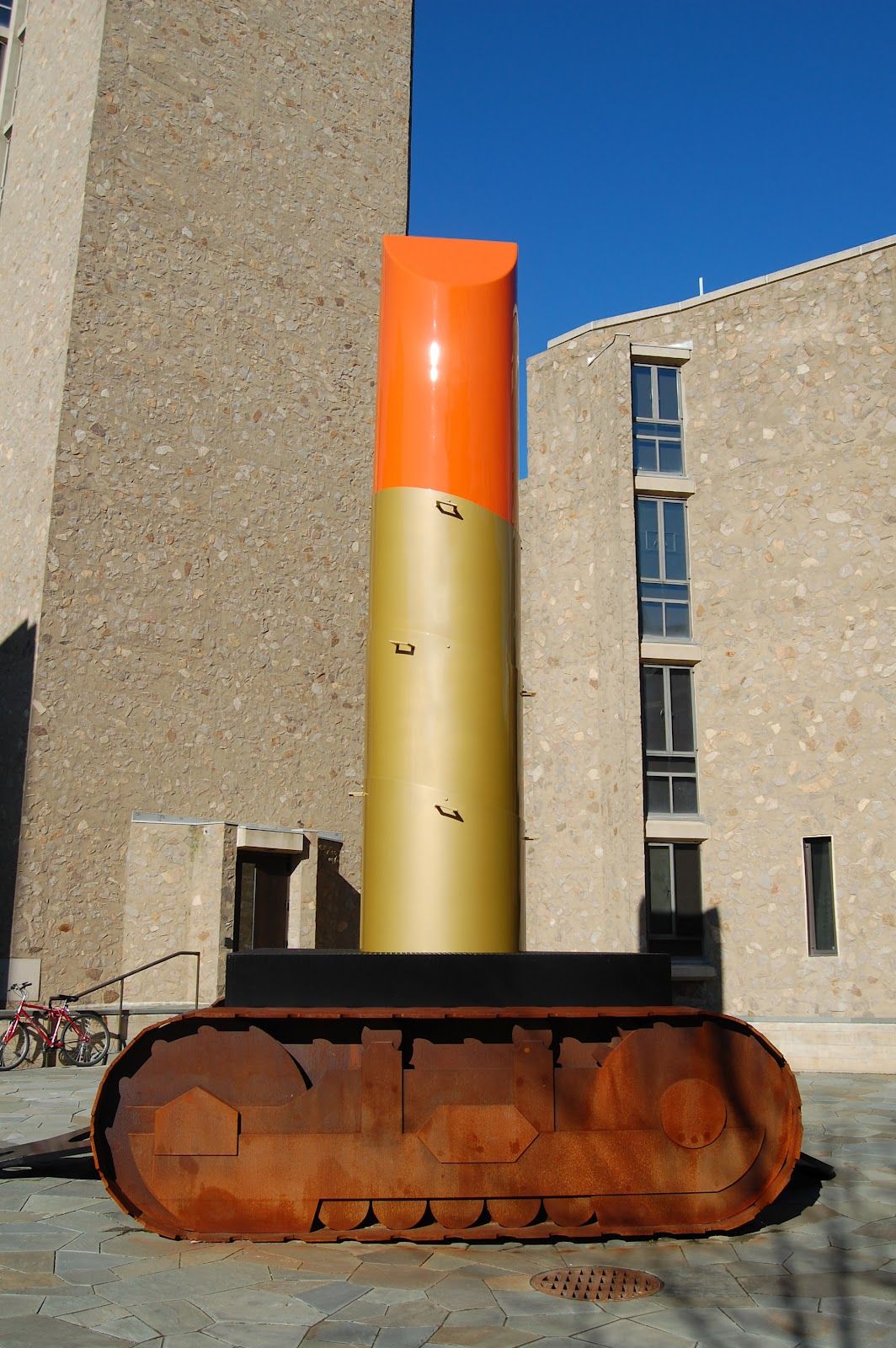
➼ Narcissus Garden
Details
- By Yayoi Kusama
- first seen in 1966
- marble installations
- Found in Venice
Function and History
- The artist originally featured the work as an uninvited participant in the 1966 Venice Biennale.
- Fifteen hundred large, mirrored, plastic balls were placed on a lawn under a sign that said “Your Narcissism for Sale.”
- The viewer is reflected seemingly into infinity in the mirrored surfaces.
- The artist offered the balls for sale for 1,200 lire ($2 each) as a commentary on the commercialism and vanity of the current art world.
- The installation later moved to water, where the floating balls reflect the natural environment—and the viewers—around the work; water placement makes a stronger connection to the ancient myth.
- Balls move with the currents of the water and wind, reflecting organically made, ever-changing viewpoints.
- The installation has been exhibited in many places around the world, both in water and in dry spaces
Context
- Narcissus Garden references the ancient myth of Narcissus, a young man who is so enraptured by his image in reflecting water that he stares at it indefinitely until he becomes a flower.
- There is a deeper meaning today as Narcissus Garden references modern obsessions with selfies and uploaded images on social media.
- Kusama is an internationally renowned Japanese-born artist:
- Got her start showing large works of art featuring huge polka dots.
- One of the foremost innovators of Happenings.
- Works in a wide variety of media, including installations.
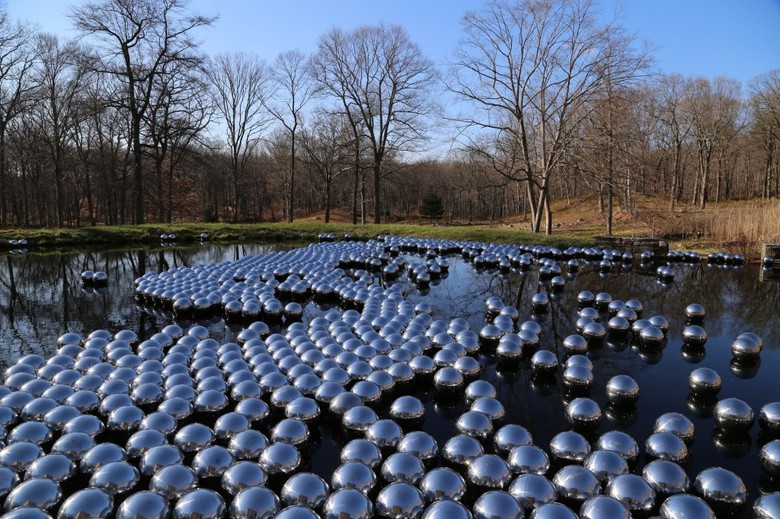
➼ Spiral Jetty
Details
- By Robert Smithson
- 1970
- earthwork: mud, precipitated salt crystals, rocks, water coil
- Found in Great Salt Lake, Utah
Form
- A coil of rock placed in a part of the Great Salt Lake that is in an extremely remote and inaccessible area.
- The artist liked the site because of the blood-red color of the water, which is due to the presence of bacteria and algae that live in the high-salt content.
Material: The artist used a tractor to move basalt from the adjacent hillside to create the jetty.
Context
- Upon walking on the jetty, the twisting and curling path changes the viewer’s view from every angle.
- A jetty is usually a pier extending into the water; here it is transformed into a curl of rocks sitting silently in a vast, empty wilderness.
- The coil is an image seen in North American earthworks—cf. Great Serpent Mound, Ohio—as well as in petroglyphs and Anasazi pottery.
- The work reflects emerging views of the environmental movement; Earth Day was inaugurated in 1970.
- Smithson wanted nature to have its effect on the jetty (sometimes it is submerged, sometimes it is visible).
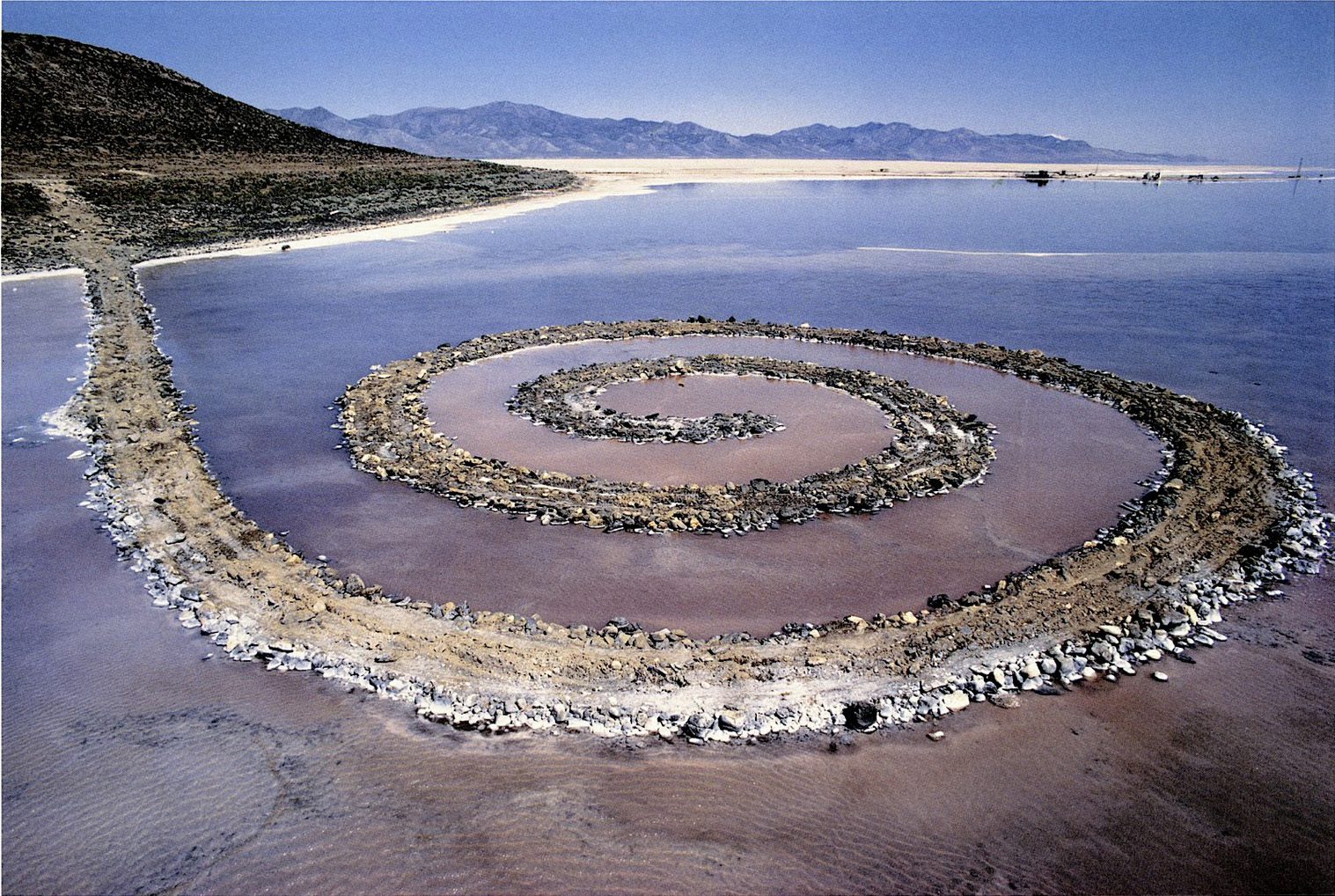
➼ House in New Castle County
Details
- By Robert Venturi, John Rauch, and Denise Scott Brown
- 1978–1983
- Made of wood frame and stucco
- Found in Delaware
Form
- The façade contains an arch inside a pediment form.
- A squat, bulging Doric colonnade is asymmetrically placed.
- The columns are actually flat rather than the traditionally round forms.
- The drainpipe at the left bisects the outermost column.
- The flattened forms on the interior arches echo the exterior flat columns.
- The interior forms reflect a craftsman’s hand in curved, cutting elements.
Function
- The house was designed for a family of three.
- For the wife, a musician, a music room was created with two pianos, an organ, and a harpsichord.
- For the husband, a bird-watcher, large windows were installed facing the woods.
Context
- Postmodern mix of historical styles.
- Rural location in low hills, grassy fields of Delaware.
- Venturi’s comment on the International style: “Less is a bore.”
